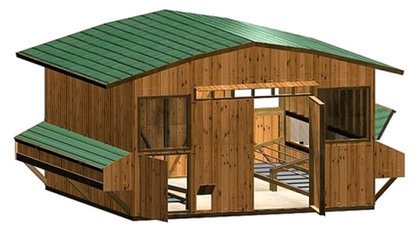Chicken Perch and Nest Box Questions
The proper chicken perches and nest boxes for your flock will be determined by a few things: The adult size of the chickens, how much room you have, and how you would like to arrange these for a nice design and best use by your chickens.
Always set perches at least a foot away from each other and avoid having perches above other perches. Chickens pass substantial droppings through the night as they digest their crop contents. The height of your perches and nest boxes are important. Roosts or chicken perches serve to protect chickens at night from possible predator harm, but mainly to give them a natural sense of security that they are as high up as they can be for the dark night and their extremely limited night vision.
Your chickens should be able to fly up to the roost without much trouble. 36” is average.
Flying up to their chicken perch is good exercise and can protect them from snakes and large rodents, even skunks at night. It’s a good idea not to have anything that predators could climb up to get to the roost, if they should get into the coop. Always lock up the coop at night. Just when you think nothing wants to bother your chickens and start leaving a door or window open is when the predators will start showing up.
The nest boxes should be a bit lower than the perches to deter chickens from roosting on the nests and getting them dirty with droppings. Allow about 2–3 feet of perch per each chicken.
In summer they like to spread out to keep cooler and they often huddle together in cold weather. I use double perch rows about 1 foot apart.
2”x4” lumber makes a good chicken perch. For Bantam breeds the 2” side is perfect, and for standard or larger breeds the 4” side provides a comfortable perch.
Wood is the best perch material, especially if your area
experiences very cold weather. Other materials, like metal or hollow pipe, will draw too much warmth away from the chicken’s feet on a cold night. 2x4's should be smooth to prevent splinters which can cause persistent foot sores.
I use plastic file boxes for chicken nests. They are easy to clean and don’t have all the nooks and crannies of wooden nest boxes for mites to hide out. I have four nests for every 16 hens. That’s all I have room for and it seems to be plenty. I’ve set them on the floor of the coop and no longer have chickens trying to roost on them at night.
A great design for a chicken perch is to place them above a wired in area. This way the heaviest concentration of droppings is protected from chickens scratching through them, which can help prevent the spread of internal parasites and feces-borne diseases. Wire under the perches can be 2"X4” welded wire. Across the front of the perch area should be a solid or wire panel that’s easily removable for cleaning below the perches.
Keeping the perches clean is important, though they may not get too dirty. If you are using smooth lumber you might want to keep a wire brush and wide putty knife in the chicken house to keep droppings from building up.
At least once a year it’s a good idea to hose out the inside of the chicken house after removing all floor litter. Choose a hot day for this so it will dry quickly.
You may want to use diluted chlorine bleach to disinfect. Scrubbing down perches and any areas of build-up will make the chicken house a much nicer place for you and the chickens.
There is a mite that bothers chickens, when it gets the opportunity. It climbs across the chicken perch at night and feeds on the chickens as they try to sleep.
Chickens need about as much sleep every night as people, so helping them to rest peacefully may mean treating for these mites. Using Food Grade Diatomacious Earth and sprinkling it on the perches and floor litter can greatly help prevent infestations, plus it’s an organic material with no harmful side effects to larger animals.
If you have questions that you would like to ask a vet, use the service below. Ask a Vet has qualified doctors that can answer questions about chicken health.
If you're still in the process of building your coop (or simply want to build a newer, better one), then I invite you to read my review where I break down two of the best chicken coop plan resources available today.
I know everyone brags about their plans so I wanted to help simplify the process for you.
Click the image below to read the review...
Chicken Perch and Nestbox Questions
.
Chicken roosts 




Why do my chickens roost on edge of nesting boxes instead of the tree branch I provided
Chicken Perches Not rated yet
Question
Can perches be made of branches with the bark on?
Answer:
They can be made of almost anything, as long as they are the correct dimensions …

Custom Search




New! Comments
Have your say about what you just read! Leave me a comment in the box below.